Posts Tagged ‘historic coins’
Historic Heads – the changing faces of UK coins
The ‘heads’, or obverse, side of a coin has depicted the image of a monarch or ruler for thousands of years.
However, the nature of these images have changed over the centuries. From the Ancient Greeks to Queen Elizabeth II, in this blog we guide you through the differing historic heads of uk coinage.

Ancient Greece and Rome

The coins of ancient Greece set the design template for the circulating coins that we use today in the UK!
On one side, their coins show a portrait of the symbol of national sovereignty and on the other side, we see something that resembles the nation.
Coins of ancient Greece and Rome were provided for city states and depict images of iconic leaders and the gods that protected them.
Roman coins depict the faces of the leaders of the empire, including Emperor Honoria.
Anglo-Saxon and Medieval Period

The Anglo–Saxon period in Britain spans approximately the six centuries from 410-1066AD.
In the ninth century The Royal Mint struck a silver penny of Alfred the Great at the time of the resettlement of London after its first occupation by the Vikings.
The coin would have been struck by hand and the design showcases the rigid markings that would have come as a result of hand tools.
The Renaissance and the Tudors

The Sovereign is undoubtedly one of the most impressive coins struck by The Royal Mint.
In 1489, Henry VII ordered a new coin of gold. The coin surface was large, enabling the engraver to include decorative details. It allowed for more detailed portraits of monarchs.
The portrait on this coin is of the crowned King Henry VIII.
Charles II

When Charles II was restored to the throne, he needed to assert his royal authority and to show a clear break from the rule of Oliver Cromwell.
It’s been suggested that the tradition of monarchs facing in the opposite direction to their predecessor on coins, dates back to Charles II when he wanted coins under his reign to be different from that of Cromwell.
Victoria

Despite reigning for 64 years, there were few coinage portraits of Queen Victoria, with one being favoured for 50 years.
For 50 years the ‘Young Head’ effigy of Queen Victoria featured on UK coinage this classically styled portrait was reinterpreted several times, with each effigy designed to portray the queen as she aged.
Queen Elizabeth II

Five portraits of Her Majesty The Queen have been used on UK coins since her accession to the throne in 1952.
The Queen’s first portrait, by Mary Gillick, shows her wearing a wreath in the style of many British coins struck between the seventeenth and early nineteenth centuries. This portrait remained on UK coins up until decimalisation, when Arnold Machin’s new portrait of The Queen was used (pictured above).
The effigy selected for use from 1985 was prepared by the sculptor Raphael Maklouf, in which she is depicted wearing a necklace and earrings.
By her fourth portrait, designed by Ian Rank-Broadley, a greater degree of realism was used. It shows The Queen in her sixth decade, her crowned head filling the coin’s surface.
The fifth and most recent portrait of The Queen is by Royal Mint designer Jody Clark. This is arguably the first UK coin to introduce elements of personality with a hint of a smile. Clark is the first Royal Mint employee in over 100 years to design a UK definitive coin portrait.
So now you know how the portraits on our coins have changed over the years, which portrait is your favourite? Comment below!
Secure the History of Britain in Coins Collector’s Album to your collection!
The ‘History of Britain in Coins’ Collector’s Album is an exciting way to collect ten specially selected UK 50p and £2 coins that Change Checker consider as some of the most historically interesting circulating coins of the decimal era!
Click here to secure your History of Britain in Coins Collector’s Album for just £25.00 (+p&p) >>
Your guide to the Pre-1997 50p Coins
In recent years, the 50 pence piece has become the most collected coin in the world.
But here at Change Checker, we get asked a lot about the older specification 50p coins… “How many old 50ps are there to collect? How rare are my old 50ps? Can I still find these coins in circulation?” are just a few of the questions frequently asked.
So, we’ve put together a guide answering your questions and giving you the key facts we think you need to know about these out-of-circulation coins!
What are old specification 50ps?
The 50p emerged in 1969 as the first coin in the new decimal series.
It was also the world’s first seven-sided coin and has since become the most collected coin in the country!
In 1997, the specification for the 50p changed to the size and feel we’re familiar with today.
But, between 1969-1997, there were five 50p coins issued in these older specifications. But what was different about these coins?
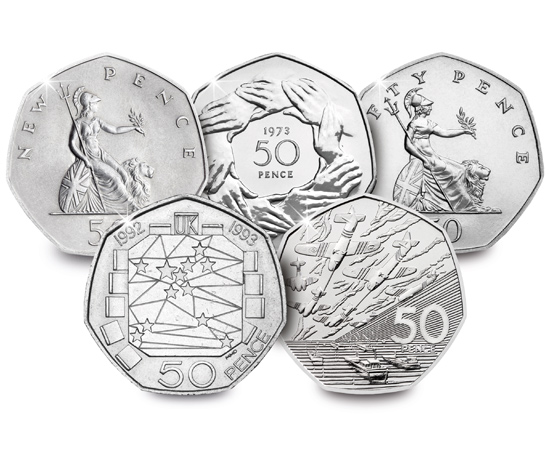
Left to Right: Britannia New Pence, Entry to the EEC, Britannia Fifty Pence, EC Presidency, D-Day
Spot the difference
| Pre-1997 (old specification) | 1998 onwards (new specification) | |
| Weight | 13.05g | 8.00g |
| Diameter | 30mm | 27.30mm |
| Metal | Cupro-Nickel | Cupro-Nickel |
| Obverse Effigy | 1969-1985 – 2nd Portrait, Arnold Machin 1985-1997 – 3rd Portrait, Raphael Maklouf | 1998-2015 – 4th Portrait, Ian Rank-Broadley 2015-onwards – 5th Portrait, Jody Clark |
As you can see, despite the 50p retaining the same metal composition, the older specification was much bigger and heavier than the coin we’re used to today – imagine carrying around a bundle of those in your pockets!
These coins were removed from circulation when the new specifications were introduced, so you won’t come across these in your change.
What’s more, shop keepers and banks won’t accept these as legal tender, so we imagine a lot of these will have been kept by collectors for their private collections!
So, how many of these coins were issued? Let’s take a look at our Pre-1997 50p Mintage Chart and see..
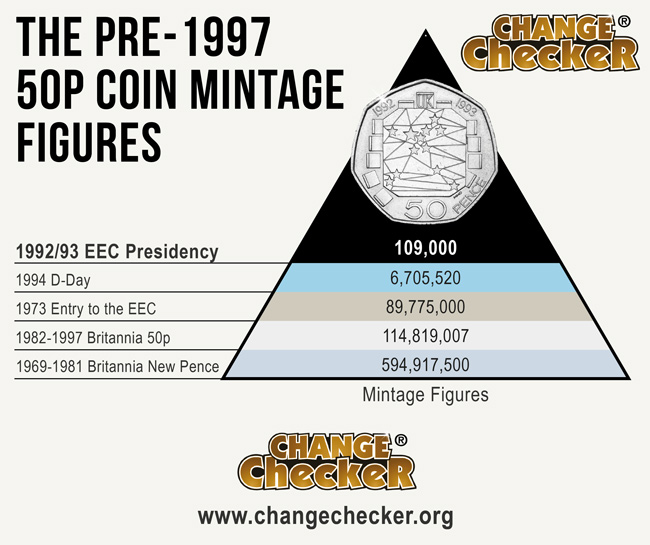
You might have spotted the top coin in our chart has a mintage of JUST 109,000! Let’s take a look at each of these coins in closer detail to get the full story..
1969 Britannia New Pence
Fact File:
- Year of Issue: 1969-1981
- Obverse Designer: Arnold Machin
- Reverse Designer: Christopher Ironside
- Mintage: 594,917,500

The New Pence 50p was the first 50p coin ever issued and it featured Christopher Ironside’s iconic Britannia design.
Britannia first appeared on UK coinage in 1672 and since then has always been present on at least one denomination.
With a mintage of 594,917,500 is the most common of the pre-1997 50p designs, which is hardly surprising as it was the definitive 50p design between 1969-1981.
Despite it’s considerably high circulating mintage, this coin is still considered collectible as it’s no longer in circulation.
1973 Entry to the EEC 50p
Fact File:
- Year of Issue: 1973
- Obverse Designer: Arnold Machin
- Reverse Designer: David Wynne
- Mintage: 89,775,000
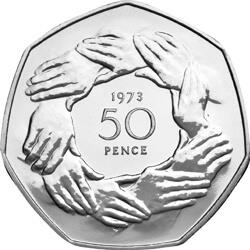
This coin was issued to celebrate the UK’s entry to the EU (then called the European Economic Council or the EEC).
With a mintage of 89,775,000 it is less common that the definitive design but not the rarest out there!
It is still incredibly sought-after by collectors though as this was the FIRST-EVER commemorative 50p!
1982 Britannia Fifty Pence
Fact File:
- Year of Issue: 1982/83/85
- Obverse Designer: Arnold Machin (1982/82) Raphael Maklouf (1985)
- Reverse Designer: Christopher Ironside
- Mintage: 114,819,007

In 1982 the ‘New Pence’ in the design was replaced with ‘Fifty Pence’ as the design was no longer considered new.
Although still the definitive design, this coin was only issued in 1982, 1983 and 1985 and featured two different portraits of Her Majesty on the obverse! Machin in ’82 and ’83 and the new Maklouf portrait in ’85.
With a mintage of 114,819,007, it’s the second most-common of the Pre-1997 50ps.
1992/93 EC Presidency 50p
Fact File:
- Year of Issue: 1992/93
- Obverse Designer: Raphael Maklouf
- Reverse Designer: Mary Milner
- Mintage: 109,000
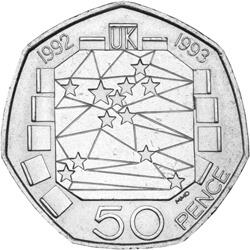
Designed by Mary Milner, this 50p celebrates the UK’s presidency of the European Council of Ministers.
Excitingly, this 50p is the RAREST ever UK 50p to enter circulation. With a mintage of just 109,000 it’s even rarer than the sought-after Kew Gardens 50p which has a mintage of 210,000.
As this coin is no longer in circulation AND has the lowest ever UK 50p circulating mintage, it’s incredibly sought-after by collectors and if you’re lucky enough to have one in your collection, you should be extremely pleased!
1994 D-Day Landings 50p
Fact File:
- Year of Issue: 1994
- Obverse Designer: Raphael Maklouf
- Reverse Designer: John Mills
- Mintage: 6,705,520
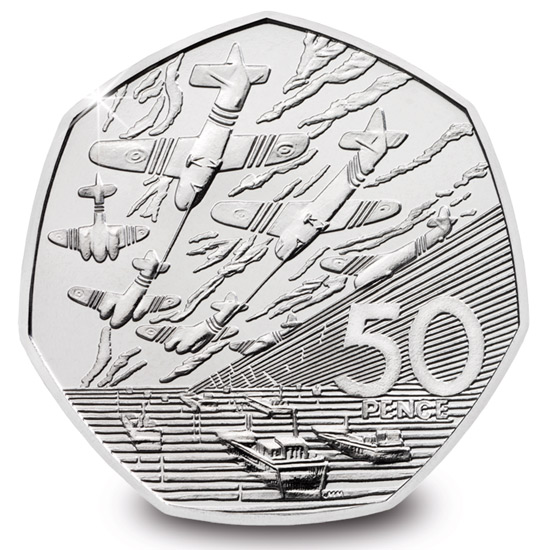
Issued to commemorate the 50th anniversary of the D-Day Landings, this was the final 50p issued in the older specifications.
Interestingly, this has been voted Change Checkers ‘Favourite Ever’ 50p!
With a mintage of 6,705,520 it is the second rarest of the pre-1997 50p coins.
So hopefully our guide to the Pre-1997 50p coins will help you along the way to expanding your collection!
What’s most exciting about all five of these coins is that now they’re out of circulation, they are all considered particularly sought-after by collectors!
Do you have any of these coins in your collection already? Let us know in the comments below!
Own the UK’s FIRST-EVER Commemorative 50p


